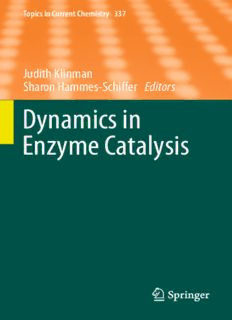
Dynamics in Enzyme Catalysis PDF
Preview Dynamics in Enzyme Catalysis
Topics in Current Chemistry 337 Judith Klinman Sharon Hammes-Schiffer Editors Dynamics in Enzyme Catalysis 337 Topics in Current Chemistry EditorialBoard: K.N.Houk,LosAngeles,CA,USA C.A.Hunter,Sheffield,UK M.J.Krische,Austin,TX,USA J.-M.Lehn,Strasbourg,France S.V.Ley,Cambridge,UK M.Olivucci,Siena,Italy J.Thiem,Hamburg,Germany M.Venturi,Bologna,Italy C.-H.Wong,Taipei,Taiwan H.N.C.Wong,Shatin,HongKong Forfurthervolumes: http://www.springer.com/series/128 Aims and Scope TheseriesTopicsinCurrentChemistry presentscriticalreviews ofthepresent and futuretrendsinmodernchemicalresearch.Thescopeofcoverageincludesallareasof chemical science including the interfaces with related disciplines such as biology, medicineandmaterialsscience. Thegoalofeachthematicvolumeistogivethenon-specialistreader,whetherat theuniversityorinindustry,acomprehensiveoverviewofanareawherenewinsights areemergingthatareofinteresttolargerscientificaudience. Thuseachreviewwithinthevolumecriticallysurveysoneaspectofthattopicand placesitwithinthecontextofthevolumeasawhole.Themostsignificantdevelop- mentsofthelast5to10yearsshouldbepresented.Adescriptionofthelaboratory procedures involved is often useful to the reader. The coverage should not be exhaustiveindata,butshouldratherbeconceptual,concentratingonthemethodolog- icalthinkingthatwill allowthenon-specialistreaderto understandtheinformation presented. Discussionofpossiblefutureresearchdirectionsintheareaiswelcome. Reviewarticlesfortheindividualvolumesareinvitedbythevolumeeditors. Readership:researchchemistsatuniversitiesorinindustry,graduatestudents. Judith Klinman Sharon Hammes-Schiffer l Editors Dynamics in Enzyme Catalysis With contributions by K.Arora(cid:1)C.L.Brooks(cid:1)C.M.Cheatum(cid:1)Q.Cui(cid:1)M.D.Daily(cid:1)K.W.Harpole(cid:1) V.J.Hilser(cid:1)D.Hilvert(cid:1)A.Kohen(cid:1)B.Ma(cid:1)V.R.Moorman(cid:1)R.Nussinov(cid:1) G.N.Phillips(cid:1)T.P.Schrank(cid:1)C.Schulenburg(cid:1)S.D.Schwartz(cid:1)A.J.Wand(cid:1) J.O.Wrabl(cid:1)H.Yu Editors JudithKlinman SharonHammes-Schiffer UniversityofCalifornia DepartmentofChemistry DepartmentofChemistry UniversityofIllinoisat DepartmentofMolecularand Urbana-Champaign CellBiology,andtheCalifornia Urbana,IL InstituteforQuantitativeBiosciences USA Berkeley,CA USA ISSN0340-1022 ISSN1436-5049(electronic) ISBN978-3-642-38961-0 ISBN978-3-642-38962-7(eBook) DOI10.1007/978-3-642-38962-7 SpringerHeidelbergNewYorkDordrechtLondon LibraryofCongressControlNumber:2013944058 #Springer-VerlagBerlinHeidelberg2013 Thisworkissubjecttocopyright.AllrightsarereservedbythePublisher,whetherthewholeorpartof the material is concerned, specifically the rights of translation, reprinting, reuse of illustrations, recitation,broadcasting,reproductiononmicrofilmsorinanyotherphysicalway,andtransmissionor informationstorageandretrieval,electronicadaptation,computersoftware,orbysimilarordissimilar methodologynowknownorhereafterdeveloped.Exemptedfromthislegalreservationarebriefexcerpts inconnectionwithreviewsorscholarlyanalysisormaterialsuppliedspecificallyforthepurposeofbeing enteredandexecutedonacomputersystem,forexclusiveusebythepurchaserofthework.Duplication ofthispublicationorpartsthereofispermittedonlyundertheprovisionsoftheCopyrightLawofthe Publisher’s location, in its current version, and permission for use must always be obtained from Springer.PermissionsforusemaybeobtainedthroughRightsLinkattheCopyrightClearanceCenter. ViolationsareliabletoprosecutionundertherespectiveCopyrightLaw. The use of general descriptive names, registered names, trademarks, service marks, etc. in this publicationdoesnotimply,evenintheabsenceofaspecificstatement,thatsuchnamesareexempt fromtherelevantprotectivelawsandregulationsandthereforefreeforgeneraluse. While the advice and information in this book are believed to be true and accurate at the date of publication,neithertheauthorsnortheeditorsnorthepublishercanacceptanylegalresponsibilityfor anyerrorsoromissionsthatmaybemade.Thepublishermakesnowarranty,expressorimplied,with respecttothematerialcontainedherein. Printedonacid-freepaper SpringerispartofSpringerScience+BusinessMedia(www.springer.com) Foreword The enormous number of three-dimensional structures for proteins that emerged duringthesecondhalfofthetwentiethcentury–asofNovember,2012,there are ca.86,000entriesintheinternationalProteinDataBase–ledquitenaturallytoan intensefocusontherelationshipbetweenproteinstructureandfunction.Therewas recognitionthatallostericproteinscouldassumedifferentshapesinthepresenceof allosteric regulators, and much work was dedicated to developing mathematical modelsforthisbehavior[1,2].Theclassicalstudiesonhemoglobinshowedhowthe remote binding of small molecules could tune the affinity of molecular oxygen at theactivesiteheme-ironcenter[3].Theseproteinmotionswereconceptualizedas rigidbodymovementsthatlinkedtheactiveandinactiveproteinstates.Thelatter halfofthetwentiethcenturysawanincreasingfocusonthemoregeneralfeatureof protein dynamics. Once again, the binding of small gaseous molecules to heme proteins played an important role, with Frauenfelder and his co-workers demon- strating aphoto-initiated,multi-exponentialrelease ofCOfrommyoglobinatlow temperature[4].Theimplicationfromthesestudieswasthattheinherentflexibility ofproteinsatroomtemperaturehadledtoafamilyoflow-temperatureconformers with different inherent kinetic properties. Concomitant with experimental approaches,Karplusandco-workersdevelopedmethodsforcomputersimulations of rapid protein motions (picosecond timescale) using Newton’s equations of motion[5]. Formanyyears,classical studiesofenzyme functionandthestudyof protein dynamics moved on largely parallel trajectories, occasionally intersecting butwithconsiderableskepticismandreservationonbothsides. The lastdecade has seen a profound shift toward the recognition that the large sizeandinherentfloppinessofproteinscanmanifestitselfateverylevelofprotein function.Thistypeofmotiongoesbeyondtwostatemodelsforallostery,aswellas the expected accommodationofaprotein’s shape to thebindingofsubstrates and their conversion to products. The emerging models include a productive and causativeroleforproteinmotionsateveryleveloffunction.Thisvolumehighlights someoftheexcitingdirectionsthatthefieldofproteindynamicshasmadeinrecent years. Here, the term “dynamics” refers to both equilibrium and non-equilibrium motions on all timescales. We have aimed at a balanced presentation of four v vi Foreword chaptersontheoryandanequalnumberonexperimentalapproaches.Thisisavery active research area, and we apologize upfront to the many investigators who are notincludedinthepresentvolume.Ourhopewasthattherangeofchapterschosen wouldhighlighttopicsthatmaynotalwaysbeconsideredinthesamecontext. From the experimental perspective, the role of protein dynamics in enzymatic bond-making and bond-cleavage events is addressed by Kohen and Cheatum. As has been discussed with increasing frequency in the literature, the enzymatic activation of C–H bonds opens up a special window for analyzing the role of heavy atom protein motions in catalysis [6]. Schulenberg and Hilvert address the very active areaofintrinsically disordered proteins,andwhetherthe propertiesof such enzymes can help us to understand the role of protein motions in native enzymecatalysis.Thecorrelationofsidechainentropyamongproteinsidechains withfunctionhasincreasinglyattractedwideattention,andWandandco-workers describe careful and insightful studies of this feature of calmodulin function according to an “entropy ruler.” Finally, Schrank, Wrabl, and Hilser talk about the role of a lid closure on the function of adenylate kinase, building upon multi- layeredexperimentaldatatogenerateamulti-statemodelfortheprogressionofthis enzymefromanopentoaclosed,catalyticallyactivestate. From the theoretical perspective, the effects of macromolecular crowding on enzymeconformationaldynamicsandactivityarediscussedbyMaandNussinov. Structured crowding, which refers to the highly organized cellular environment, could potentially enhance enzyme efficiency and specificity. Cui and coworkers discusshowatomisticandcoarse-grainedsimulationscanbeusedtoelucidatethe mechanism of activation transitions, which often precede the chemical steps in enzymes and are typically allosteric and multiscale in nature. In the simplest enzymes, such as adenylate kinase, the activation transition corresponds to the closure of the active site, but in biomolecular motors, such as myosin, it is more complex.AroraandBrooksfocusontheenzymedihydrofolatereductase(DHFR), which catalyzes the hydride transfer reaction required for the conversion of dihy- drofolatetotetrahydrofolate.Thisenzymehasbeenstudiedextensivelywithawide range of theoretical and experimental methods. The consensus is that equilibrium conformational motions of the protein and ligands impact catalysis in DHFR by generatingconfigurationsconducivetothehydridetransferreaction,butthereisno evidencefordynamicalcouplingofproteinvibrationalmodestothebreakingand formingofchemicalbonds[7].Schwartzproposesamorecontroversialperspective about the role of protein dynamics in enzyme catalysis. While he agrees with the above interpretation for DHFR, he also proposes that femtosecond to picosecond “promoting vibrations” of the protein can be directly coupled to the passage over thechemicalbarrier(i.e.,tobondbreaking/forming)andarecatalyticallyrelevant forotherenzymes,suchaslactatedehydrogenaseandpurinenucleosidephosphor- ylase.Thisaspectofcatalysiscontrastswiththemoregenerallyacceptedmodelof equilibrium conformational sampling that has components of protein motions rangingfromfemtosecondtomillisecondtimescales. Asthereaderwillsee,theincludedchaptersare,attimes,eithercomplementary ordivergentintheirconclusions.Webelievethatthisreflectsthecurrentvibrancy Foreword vii of the field of protein dynamics. One of the goals of this community – hopefully achievableinthecomingdecades–willbetodevelopalevelofunderstandingthat allows us to replicate in the test tube the exquisite specificity and enormous catalyticrateaccelerationsofnativeproteins. References 1. Monod J, Wyman J, Changeux JP (1965) On nature of allosteric transitions – a plausible model.JMolBiol12:88–188 2. KoshlandDE,NemethyG,FilmerD(1966)Comparisonofexperimentalbindingdataand theoreticalmodelsinproteinscontainingsubunits.Biochemistry5:365–368 3. EdelsteinSJ(1975)Cooperativeinteractionsofhemoglobin.AnnuRevBiochem44:209–232 4. HongMK,BraunsteinD,CowenBR,FrauenfelderH,IbenIET,MourantJR,OrmosP,Scholl R,SchulteA,SteinbachPJ,XieAH,YoungRD(1990)Conformationalsubstatesandmotions inmyoglobin–externalinfluencesonstructureanddynamics.BiophysJ58:429–436 5. Brooks BR, Bruccoleri RE, Olafson BD, States DJ, Swaminathan S, Karplus M (1983) Charmm–aprogramformacromolecularenergy,minimization,anddynamicscalculations. JComputChem4:187–217 6. Klinman JP (2009) An integrated model for enzyme catalysis emerges from studies of hydrogentunneling.ChemPhysLettFontiers471:179–193 7. Hammes-Schiffer S, Benkovic SJ (2006) Relating protein motion to catalysis. Annu Rev Biochem75:519–541 ThiSisaFMBlankPage Contents RelationshipofFemtosecond–PicosecondDynamicsto Enzyme-CatalyzedH-Transfer ................................................ 1 ChristopherM.CheatumandAmnonKohen ProteinConformationalDisorderandEnzymeCatalysis .................. 41 CindySchulenburgandDonaldHilvert ASurprisingRoleforConformationalEntropyinProteinFunction ..... 69 A.JoshuaWand,VeronicaR.Moorman,andKyleW.Harpole ConformationalHeterogeneityWithintheLIDDomainMediates SubstrateBindingtoEscherichiacoliAdenylateKinase: FunctionFollowsFluctuations ............................................... 95 TravisP.Schrank,JamesO.Wrabl,andVincentJ.Hilser StructuredCrowdingandItsEffectsonEnzymeCatalysis .............. 123 BuyongMaandRuthNussinov AllostericActivationTransitionsinEnzymesandBiomolecularMotors: InsightsfromAtomisticandCoarse-GrainedSimulations ............... 139 MichaelD.Daily,HaiboYu,GeorgeN.PhillipsJr,andQiangCui MultipleIntermediates,DiverseConformations,andCooperative ConformationalChangesUnderlietheCatalyticHydrideTransfer ReactionofDihydrofolateReductase ....................................... 165 KaruneshAroraandCharlesL.BrooksIII ProteinDynamicsandtheEnzymaticReactionCoordinate .............. 189 StevenD.Schwartz Index .......................................................................... 209 ix
Description: